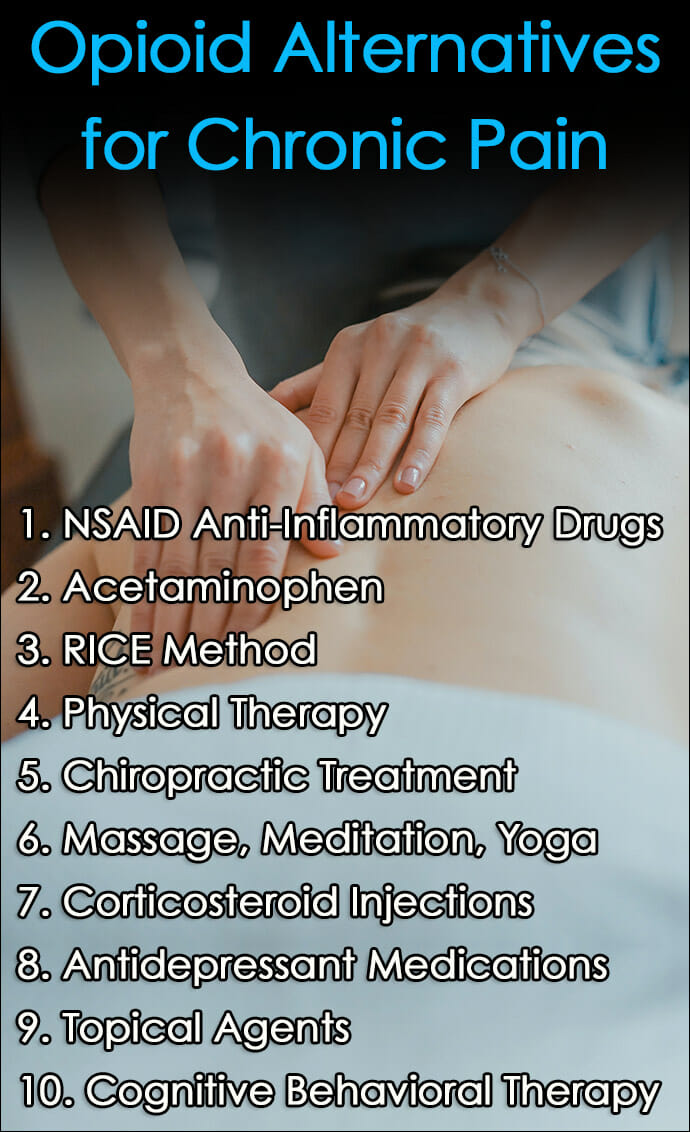Table of Contents
It’s not surprising that many pharmacists, doctors, and pain experts now suggest opioid alternatives for chronic pain management, instead of opiate prescription painkillers.
For the past several decades, doctors routinely prescribed opioid painkillers in large quantities for acute and chronic pain management, especially following injury or surgical procedures.
Even though they may have been appropriate in some instances, these highly addictive painkillers caused an epidemic of addiction and overdose.
Pain, whether caused by disease or injury, can be physically, psychologically, and emotionally debilitating.
While people suffering from acute pain may eventually find relief as the body recovers from illness or physical trauma, the experience can still be draining. For those suffering from chronic pain, the outlook can seem bleak and hopeless.
For these reasons, it makes perfect sense that people in pain would gravitate toward opioid painkillers. Not only were they readily available and overly prescribed, they were also highly effective at treating short and long-term pain.
However, prescription opioid painkillers come with a serious dark side because they are highly addictive.
For those who get hooked and want to stop taking them, opioid drugs can cause painful withdrawal symptoms. Severe opioid withdrawal makes kicking the habit extremely difficult and usually requires a drug detox program to safely manage the symptoms.
The Dangers of Opioids for Chronic Pain Management
The U.S. Department of Health and Human Services reports that in 2019, an estimated 9.7 million people misused or abused prescription painkillers.
While a small percentage of these people are recreational drug users, a vast majority of them are people with a prescription for drugs like Vicodin, Percocet, Hydrocodone, Oxycodone and others.
One of the primary reasons opioid painkillers should only be used for a short period of time is because a person quickly develops a tolerance to the medication, meaning they need to take more of the drug to experience the same effects.
A person’s tolerance to opioids can develop in a relatively short amount of time, sometimes in just a few weeks. Most people think if a medication is prescribed, it is safe. That’s not necessarily true.
Those prescribed opioid painkillers can unwittingly become dependent on the drug by misusing it or taking it for longer than is an absolutely necessary.
Even starker are the number of opioid related deaths in the past 20 years.
According to the Centers for Disease Control and Prevention, between 1999 and 2019, nearly 500,000 people died as a result of a fatal overdose to opioids. Nearly 107,000 drug overdose deaths in 2022 involved an opioid.
Anyone who develops a dependency to these drugs, whether they are legal prescription opioids, or illegal drugs like heroin or a fentanyl addiction, he or she should seek professional treatment.
Opioid use disorder is treatable, but because of the severe detox symptoms, many patients will need to be monitored by medical professionals as their body clears itself of the drug.
The addictive nature of prescription opioids, along with the danger of fatal overdose, is why many in the healthcare industry are only prescribing the drugs as a last resort, and only for the most severe cases.
Many doctors, pharmacists and pain specialists now go to great lengths to provide opioid alternatives for the treatment of chronic pain.
Here are 10 Opioid Alternatives for Chronic Pain Management
1. Non-Steroidal Anti-Inflammatory Drugs (NSAIDs)
Non-Steroidal Anti-Inflammatory Drugs, or NSAIDs, are over-the-counter pain medications like ibuprofen (Advil) and naproxen (Aleve). NSAIDs are not addictive or habit forming like opioids, and when taken as directed they can help reduce many forms of pain and also inflammation.
2. Acetaminophen or Tylenol as Opioid Alternatives
Acetaminophen is the generic for Tylenol and is another over-the-counter analgesic that is non-habit forming. With Acetaminophen, it’s important to use it as recommended and avoid alcohol because this combination can cause unhealthy side effects.
3. RICE Method
The RICE Method stands for Rest, ice, Compression and Elevation (RICE). This injury treatment approach can be effective at allowing the body to heal from pain and soft-tissue injuries, especially if started early and completed for the proper duration.
Rest gives the body time to heal the injury, while ice can help reduce swelling and pain. Compression supports the injured area, and elevating it above the heart decreases inflammation and allows excess fluid to drain away from the injury.
4. Physical Therapy
Physical Therapy uses trained therapists who are knowledgeable about ways to help people strengthen and heal injured areas of the body. Learning how to build strength and improve flexibility can help diminish pain as well as reducing the likelihood of developing other injuries in the future.
5. Chiropractic Treatment
Chiropractic Treatment focuses on the body’s alignment to help reduce pain and improve function, primarily as it concerns the spine. According to Harvard Health, modern chiropractors are also focusing on postural and exercise education, along with techniques for standing, walking, and sitting to limit unhealthy strain on the back.
6. Massage, Mindful Meditation, Yoga, and Exercise
While many people may tend to write-off approaches to pain treatment like Massage, Mindful Meditation, Yoga, and Exercise, there is plenty of evidence to suggest that they can have a serious impact on chronic pain.
For instance, mindful meditation has shown to quiet areas of the brain associated with pain.
Activities like massage can increase blood flow and reduce inflammation, while exercise and yoga movements strengthen the body and increase oxygen intake, which also promote healing.
All forms of movement have shown to be effective for improving physical and mental health by increasing endorphin production, which is the body’s own natural pain reliever.
7. Corticosteroid Injections
Corticosteroid Injections are powerful anti-inflammatories that are effective in reducing pain and inflammation in certain areas of the body, particularly the joints. These injections may be appropriate for some people to overcome pain, though this tends to be a short-term solution and people may experience varying lengths of relief.
Cortisone injections were once quite popular at reducing inflammation caused by injuries, but they are now only used for specific conditions.
8. Antidepressant Medication or Nerve Pain Prescriptions
In some instances, Antidepressant Medications or Nerve Pain Prescriptions serve as opioid alternatives to help reduce pain. These are often used as what’s called “off-label prescriptions,” meaning the medications are generally approved for something else other than pain.
The antidepressants Effexor (Venlafaxine) and Cymbalta (Duloxetine) are generally prescribed for depression, though both have shown to help with pain associated with conditions like diabetic peripheral neuropathy, chronic bone or muscle pain, and fibromyalgia.
Gabapentin is a medication prescribed for epilepsy, but is known to be effective in treating nerve pain brought on by illnesses like shingles and diabetes. It is also used for treating restless leg syndrome.
9. Topical Agents
Topical Agents or creams like Lidocaine and Capsaicin are rubbed directly on areas of the body experiencing pain, swelling, or both. These topical agents have anti-inflammatory properties that can improve discomfort. They may also act faster than pills, which take time to enter the bloodstream.
10. Cognitive Behavioral Therapy for Chronic Pain Management
Cognitive Behavioral Therapy (CBT) is a skills-based treatment therapy that helps shift a person’s perception of pain and other issues by challenging engrained or negative thought patterns.
After a limited number of sessions with a counselor trained in CBT, people are often able to change the way they feel, even physically, by reframing their perception and thought processes related to a particular situation.
Additional Opioid Alternatives for Chronic Pain Management
The 10 treatment alternatives to opioids for chronic pain management listed above are fairly easy to incorporate and are generally accessible for most people.
Most of them have shown to be effective for many different types of pain and are much safer than opioids.
Other Opioid Alternatives for Pain Include:
- Acupuncture
- Neurofeedback
- EPAT Therapy
- Biologics like PRP and Stem Cells
- Nerve blocks
- Epsom Salts and Magnesium
- TENs Units
- Laser Therapy
- Marijuana
Some of these are less common than traditional treatments and may only work for certain types of pain or injuries. Nonetheless, quite a few people have found them to be quite effective.
Marijuana is a drug that isn’t legal in all states and is frowned upon as a treatment method by many people, but has found a welcome community where medical cannabis is concerned.
It should be noted that it can be addictive and there are also known side effects of weed consumption. With that said, marijuana is much less dangerous or addictive than opioids.
When considering any method of chronic pain management, it is always highly recommended to consider all opioid alternatives first.
If opioids are necessary when all other alternatives have not been successful, they should only be used sparingly for a short period of time, and only as prescribed.





